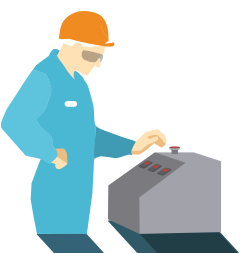Elementary Components of a Workplace
To compose a rudimentary workstation only a few basic elements are needed:
- workbench (see Figures 1a, 1b, 1c),
- chair (see Figures 2a, 2b),
- possibly a footrest (see Figures 3a, 3b), and
- equipment and assessor examples (see Figure 4).
All components should be adaptable in height to cope with different sizes of users.
Workbench



Figure 1a: For a single user, working in sitting position, offering a possibility for a one-time-adjustment in height, e.g. with locking screws
Figure 1b: For a tall man working in standing position, offering a possibility for a one-time-adjustment in height, e.g. with locking screws.
Figure 1c: When different people are using the same workstation or different tasks are carried out at the same workstation, a workbench should be easily and quickly adjustable, e.g. with electric or hydraulic adjustment systems.
Industrial Work Chair


Figure 2a: Work chair, adjustable in height, inclinable seat and adjustable backrest, wheeled safety castors
Figure 2b: High work chair with safety glides and mounting step (adjustability of the seat of the high chair from 90 - 115 cm. Such chairs may not be equipped with free running wheels to avoid accidents.)
Footrest
If the working height cannot be completely adjusted and the feet cannot rest completely on the floor; a footrest must be used.


Figure 3a: Footrest fully integrated in a workbench, easily adjustable by foot in height and inclination.
Figure 3b: Alternatives: uncoupled solid footrest; large enough for both feet; easy adjustable in height and inclination
Equipment and Accessories (example)
Figure 4: Hydraulic Scissor Lift Trolley to facilitate manipulation and transportation of material and goods at ideal level

References:
- ISO 7174-1. Furniture – Chairs - Determination of stability - Part 1: Upright chairs and stools.
- ISO 7174-2. Furniture – Chairs - Determination of stability - Part 2: Chairs with tilting or reclining mechanisms when fully reclined, and rocking chairs.

